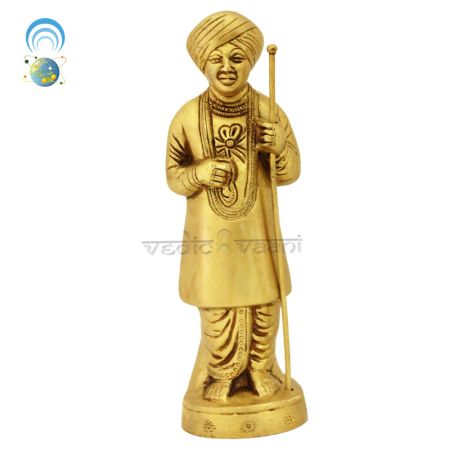Jalaram Bapa was born in Virpur, Rajkot district, Gujarat, India in 1799, on the seventh day of the Kartika month. His father was Pradhan Thakkar and his mother was Rajbai Thakkar who belonged to Thakkar clan, which is a sub-group of Lohana clan. He was a devotee of the Hindu god Rama.
Jalaram Bapa was however not willing to live an householder's life and continued to take care of his fathers business. He was mostly engaged in serving pilgrims, sadhus and saints. He separated himself from his father's business and his uncle Valjibhai asked Jalaram Bapa and his wife Virbai to stay in his house.
At the age of sixteen, in 1816, Jalaram married Virbai, the daughter of Pragjibhai Thakkar (Somaiya) of Atkot. However, he was inclined to completely withdraw from materialistic life and become an ascetic, Virbai proved to be an asset to him in his works of feeding poor and needy.
At the age of 18, soon after returning from pilgrimage to Hindu holy places, Jalaram Bapa became the disciple of Bhoja Bhagat of Fatehpur, who accepted him as his disciple. Jalaram was given the "Guru Mantra" (mantra) and japa mala in the name of Rama by his Guru Bhojalram. With blessings of his guru, he started "Sadavrat", a feeding center, a place where all sadhus and saints as well as the needy could have food any time.
One day, a sadhu who came to his house gave him a deity of Lord Rama, forecasting that Hanuman, the monkey-god and devotee of Rama, would follow soon. Jalaram Bapa installed Rama as his family deity and after a few days, a deity of Hanuman appeared out of earth, on its own. The deity of Rama's consort Sita and his brother Lakshmana also appeared. Due to a miracle the container in the house of Jalaram, where grains were stored, became inexhaustible. Later other devotees and village folk joined him in his works of human welfare.
Soon his fame spread as an divine incarnation. Whoever came to Virpur, whether Hindu or Muslim irrespective of caste, creed and religion were fed by Jalaram. This tradition of feeding people continues to this day in Virpur.
With blessings of his guru, he started "Sadavrat" a feeding centre, a place where all sadhus and saints as well as the needy could have food any time during 24 hours. Nobody returned from that place without having food. All this he did single handed with Virbaima assisting him. Soon his fame spread as an incarnation of the divine. Whoever come to Virpur, whether Hindu or Muslim was fed by Bapa.
Design: Made in heavy shining brass.
Brass is well known for its grasping capacity. It grasps the divine spirit upto 30%, when compared to other metals. The spiritual vibrations are attracted towards these shining idols easily.
Dimensions: 7.2 inches (H) x 2.2 inches (W) x 1.5 inches (thickness)
Weight: 980 gms
Importance of Idol worship: Idols are not the idle fancies of sculptors, but shining channels through which the heart of the devotee is attracted to and flows towards God. Though the image is worshipped, the devotee feels the presence of the Lord in it and pours out his devotion unto it. Regular worship, Puja and other modes of demonstrating our inner feeling of recognition of Divinity in the idol unveils the Divinity latent in it. This is truly a wonder and a miracle. The picture comes to life. The idol speaks. It will answer your questions and solve your problems. The God in you has the power to awaken the latent Divinity in the idol. The lives of Mirabai, Sant Tukaram, Shri Ramakrishna Paramhansa and Shri Yogananda are a few instances to prove the point. They proved beyond doubt that idol worship has its own brighter side and through simple faith and intense devotion one can realize God through it.
Idols are the "finite representation of the Infinite". As per Vishnu Samhita (ch 29, v 55-7), persuasively endorses the use of imagery (idols) and puts it: "Without a form how can God be mediated upon? If (He is) without any form, where will the mind fix itself? When there is nothing for the mind to attach itself to, it will slip away from meditation or will glide into a state of slumber. Therefore the wise will meditate on some form, remembering, however, that the form is a superimposition and not a reality."
| Show On Homepage | No |
|---|---|
| Short Description | The idol of Jalaram Bapa is shown as a smiling man holding danda and wearing often a white paghadi and white dhoti-kurta. The deities of his patron deities Rama, Sita, Lakshmana and Hanuman are also mostly found along with his idol. |








































